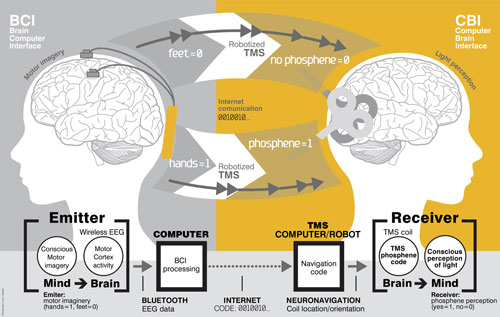| Sep 03, 2014 |
Researchers demonstrate direct human brain-to-brain communication via the internet
|
|
(Nanowerk News) In a first-of-its-kind study, an international team of neuroscientists and robotics engineers have demonstrated the viability of direct brain-to-brain communication in humans. Recently published in PLOS ONE ("Conscious Brain-to-Brain Communication in Humans Using Non-Invasive Technologies") the highly novel findings describe the successful transmission of information via the internet between the intact scalps of two human subjects – located 5,000 miles apart.
|
 |
| Brain-to-brain (B2B) communication system overview. On the left, the BCI subsystem is shown schematically, including electrodes over the motor cortex and the EEG amplifier/transmitter wireless box in the cap. Motor imagery of the feet codes the bit value 0, of the hands codes bit value 1. On the right, the CBI system is illustrated, highlighting the role of coil orientation for encoding the two bit values. Communication between the BCI and CBI components is mediated by the internet. (click on image to enlarge)
|
|
"We wanted to find out if one could communicate directly between two people by reading out the brain activity from one person and injecting brain activity into the second person, and do so across great physical distances by leveraging existing communication pathways," explains coauthor Alvaro Pascual-Leone, MD, PhD, Director of the Berenson-Allen Center for Noninvasive Brain Stimulation at Beth Israel Deaconess Medical Center (BIDMC) and Professor of Neurology at Harvard Medical School. "One such pathway is, of course, the internet, so our question became, 'Could we develop an experiment that would bypass the talking or typing part of internet and establish direct brain-to-brain communication between subjects located far away from each other in India and France ?'"
|
|
It turned out the answer was "yes."
|
|
In the neuroscientific equivalent of instant messaging, Pascual-Leone, together with Giulio Ruffini and Carles Grau leading a team of researchers from Starlab Barcelona, Spain, and Michel Berg, leading a team from Axilum Robotics, Strasbourg, France, successfully transmitted the words "hola" and "ciao" in a computer-mediated brain-to-brain transmission from a location in India to a location in France using internet-linked electroencephalogram (EEG) and robot-assisted and image-guided transcranial magnetic stimulation (TMS) technologies.
|
|
Previous studies on EEG-based brain-computer interaction (BCI) have typically made use of communication between a human brain and computer. In these studies, electrodes attached to a person's scalp record electrical currents in the brain as a person realizes an action-thought, such as consciously thinking about moving the arm or leg. The computer then interprets that signal and translates it to a control output, such as a robot or wheelchair.
|
|
But, in this new study, the research team added a second human brain on the other end of the system. Four healthy participants, aged 28 to 50, participated in the study. One of the four subjects was assigned to the brain-computer interface (BCI) branch and was the sender of the words; the other three were assigned to the computer-brain interface (CBI) branch of the experiments and received the messages and had to understand them.
|
|
Using EEG, the research team first translated the greetings "hola" and "ciao" into binary code and then emailed the results from India to France. There a computer-brain interface transmitted the message to the receiver's brain through noninvasive brain stimulation. The subjects experienced this as phosphenes, flashes of light in their peripheral vision. The light appeared in numerical sequences that enabled the receiver to decode the information in the message, and while the subjects did not report feeling anything, they did correctly receive the greetings.
|
|
A second similar experiment was conducted between individuals in Spain and France, with the end result a total error rate of just 15 percent, 11 percent on the decoding end and five percent on the initial coding side.
|
|
"By using advanced precision neuro-technologies including wireless EEG and robotized TMS, we were able to directly and noninvasively transmit a thought from one person to another, without them having to speak or write," says Pascual-Leone. "This in itself is a remarkable step in human communication, but being able to do so across a distance of thousands of miles is a critically important proof-of-principle for the development of brain-to-brain communications. We believe these experiments represent an important first step in exploring the feasibility of complementing or bypassing traditional language-based or motor-based communication."
|

